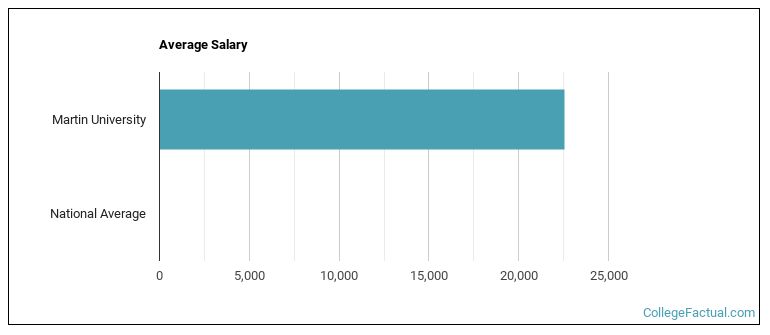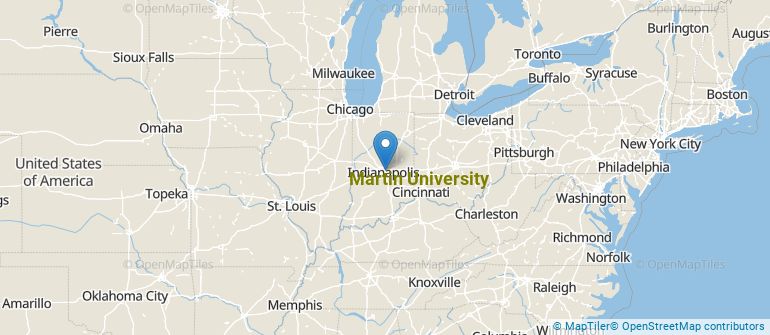 by our College Data Analytics Team
by our College Data Analytics TeamExplore the best ranked schools for the programs you are most interested in.
Martin University was not ranked in College Factual's 2025 Best Overall Colleges report. This could be for a number of reasons, including lack of data.
If you are worried about getting into Martin University, don't be. The school has a liberal open admissions policy, which means you only need to meet basic requirements in order to be admitted. Still, be sure to submit a complete application and provide any other requested materials.
The student to faculty ratio at Martin University is an impressive 6 to 1. That's quite good when you compare it to the national average of 15 to 1. This is a good sign that students at the school will have more opportunities for one-on-one interactions with their professors.
When estimating how much access students will have to their teachers, some people like to look at what percentage of faculty members are full time. This is because part-time teachers may not have as much time to spend on campus as their full-time counterparts.
The full-time faculty percentage at Martin University is 69%. This is higher than the national average of 47%.
The freshmen retention rate tells us what percentage of first-year, full-time students choose to continue on to their sophomore year at a particular school. The rate at Martin University is 67%, which is about average when compared to the national rate of 68%.
The on-time graduation rate is the percent of first-time, full time students who obtain their bachelor's degree in four years or less. This rate is 10% for first-time, full-time students at Martin University, which is lower than the national rate of 33.3%.
Find out more about the retention and graduation rates at Martin University.
During the 2017-2018 academic year, there were 170 undergraduates at Martin University with 82 being full-time and 88 being part-time.
The net price is calculated by adding tuition, room, board and other costs and subtracting financial aid.Note that the net price is typically less than the published for a school. For more information on the sticker price of Martin University, see our tuition and fees and room and board pages.
While almost two-thirds of students nationwide take out loans to pay for college, the percentage may be quite different for the school you plan on attending. At Martin University, approximately 100% of students took out student loans averaging $8,631 a year. That adds up to $34,524 over four years for those students.

Get more details about the location of Martin University.

Contact details for Martin University are given below.
| Contact Details | |
|---|---|
| Address: | 2186 North Sherman Drive, Indianapolis, IN 46218-0567 |
| Phone: | 317-543-3235 |
| Website: | www.martin.edu/ |
| Most Popular Majors | Bachelor’s Degrees | Average Salary of Graduates |
|---|---|---|
| Clinical, Counseling & Applied Psychology | 24 | NA |
| Business Administration & Management | 8 | NA |
| General Psychology | 8 | NA |
| Mental & Social Health Services | 5 | NA |
| Liberal Arts General Studies | 3 | NA |
| Criminal Justice & Corrections | 3 | NA |
| Pastoral Counseling & Specialized Ministries | 2 | NA |
| Teacher Education Grade Specific | 1 | NA |
| Religious Studies | 1 | NA |
Online courses area a great option for busy, working students as well as for those who have scheduling conflicts and want to study on their own time. As time goes by, expect to see more and more online learning options become available.
In 2022-2023, 168 students took at least one online class at Martin University. This is an increase from the 0 students who took online classes the previous year.
| Year | Took at Least One Online Class | Took All Classes Online |
|---|---|---|
| 2022-2023 | 168 | 0 |
| 2021-2022 | 0 | 0 |
| 2020-2021 | 220 | 0 |
| 2018-2019 | 0 | 0 |
If you’re considering Martin University, here are some more schools you may be interested in knowing more about.
Curious on how these schools stack up against Martin University? Pit them head to head with College Combat, our free interactive tool that lets you compare college on the features that matter most to you!
Footnotes
*The racial-ethnic minorities count is calculated by taking the total number of students and subtracting white students, international students, and students whose race/ethnicity was unknown. This number is then divided by the total number of students at the school to obtain the racial-ethnic minorities percentage.
References
More about our data sources and methodologies.